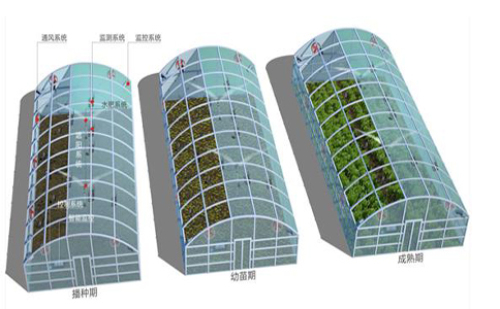Introduction: The remote monitoring system for agricultural greenhouse greenhouses consists of temperature and humidity sensors, light sensors, C02 concentration detectors, and leaf surface humidity sensors to complete the monitoring, summarization, conversion, and transmission of environmental parameters. Combined with the control part, it can be completed. For the monitoring of the greenhouse environment.

The sensor is an important part of the detection process of the greenhouse temperature and humidity monitoring system. The sensors in the greenhouse are used to convert non-electrical physical factors such as greenhouse environmental factors into identifiable electrical signals of the control system, and provide basis for judgment and processing of system management control. The main technical indicators of the sensor are: linearity, sensitivity, hysteresis, repeatability, resolution, drift, accuracy, and so on. Commonly used sensors include temperature and humidity sensors, light sensors, CO2 (carbon dioxide) sensors, soil temperature and humidity sensors, and salt (EC) and acidity (PH) sensors for nutrient solutions.
(1) Air temperature and humidity sensor
The suitable growth temperature of most crops is between 12°C and 33°C, while the temperature measurement range in the greenhouse is generally between 0°C and 80°C, the humidity measurement range is between 0% and 100%RH, the power supply voltage adopts industrial standard 24VDC, standard industry The output signal is (4 ~ 20) mA, the precision is temperature ± 0.5 °C, humidity ± 3% RH, the output signal is linear, and can be transmitted over long distances.
Temperature and humidity sensors are mainly divided into indoor and outdoor temperature and humidity collection units, outdoors generally use light shutter type temperature and humidity, can prevent solar radiation and rain. In the room, temperature and humidity sensors with and without display are generally used. Regardless of the type of sensor, their role is to collect indoor and outdoor temperature and humidity parameters in real time and send it to the control cabinet through the data line, to complete the collection of front-end data. Based on the data sent back from the sensor, the system will control the output of the device that determines the temperature of the device, and adjust the temperature and humidity parameters in the room.
(2) Selection of illumination sensor
Light is the main energy source for photosynthesis of plants. It is related to light intensity and illumination time. It uses a highly sensitive silicon blue photovoltaic detector as a sensor, which has a wide measuring range, is easy to use, easy to install, and has a long transmission distance. The power supply voltage is 24VDC, the precision is ±7%, the measurement range is 0-200KLux, the output signal is (4-20)mA, the operating environment temperature is 0-70°C, and the humidity is 0-70%RH. The light sensor is mainly used in the outdoor environment. For outdoor sunlight detection, it is sent to the controller. The controller determines whether to enable the greenhouse shade net through internal calculation and logic judgment.
(3) CO2 sensor
Transmitters for high standards of carbon dioxide, the sensor using silicon-based non-scattering infrared sensor with a unique internal referencing; advanced single beam, dual wavelength measurement, no moving parts, excellent long-term stability. The sensor monitors the CO2 concentration in the room in real time and regulates the CO2 gas replenishment to ensure the required concentration of carbon dioxide under the photosynthesis of indoor plants.
(4) Soil temperature and humidity sensor
Plants mainly rely on the water that the root system absorbs from the soil to supply plant growth and development, metabolism and other physiological activities and transpiration. More than 90% of the water needed for photosynthesis and transpiration of plants comes from the absorption of water in the soil, and the amount of water absorbed by the roots is closely related to the soil temperature, so the soil temperature and soil moisture (moisture) are the crop growth during the planting process. Is an important factor. The selection range of the soil temperature and humidity sensor is generally between -20°C~+85°C, humidity 0~100%RH, working condition temperature -15°C~60°C, and humidity 10%RH~80%RH. For the demand of wireless transmission, long-distance transmission of soil temperature and humidity sensors can be selected.
(5) Soil salt detector
Soil salinity is an important indicator of the healthy growth of crops. Excessive soil salinity can lead to physiological drought in the plant. Due to the poisonous effect of ions in the soil, the normal metabolism of the plant will be destroyed, resulting in the destruction or death of the plant. For the selection of soil salinity sensors, attention should be paid to the range of salt concentration 0.01mol/L~0.3mol/L, conductivity 0mS~20mS; working conditions selection temperature -10°C~60°C, humidity 10%RH~90%RH.
(6) Soil pH detector
Soil pH is an important indicator for the survival of plants, soil pH will not greatly affect plant growth. Soil pH sensor (soil conductivity sensor) is a new-generation conductivity soil pH sensor developed by our company based on the theory of conductance and frequency domain measurement technology. Capable of measuring the conductivity characteristics of the soil (or other media) and many (small) porous media, into a voltage signal and output linearization standard for real-time monitoring of the conductivity of the soil / medium. At present, this product has been widely used for on-line measurement of soil conductivity in agricultural irrigation, agricultural soil acidity and alkalinity, sand soil planting and concrete mixing. The range of soil pH sensors is generally 3PH~8PH.
The remote monitoring system for agricultural greenhouse greenhouses consists of temperature and humidity sensors, light sensors, C02 concentration detectors, and leaf surface humidity sensors to complete the monitoring, summarization, conversion and transmission of environmental parameters. Combined with the control part, the greenhouse Environmental monitoring.
Cordless Drywall Screw Gun,Zinc Plated Lead Screw,Zinc Plated Guide Screw,Locking Plastic Rings Drywall Screw